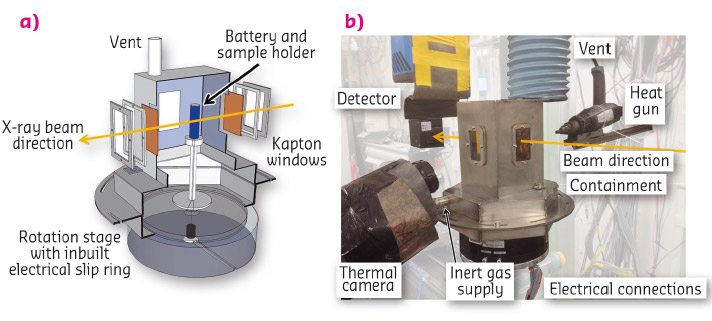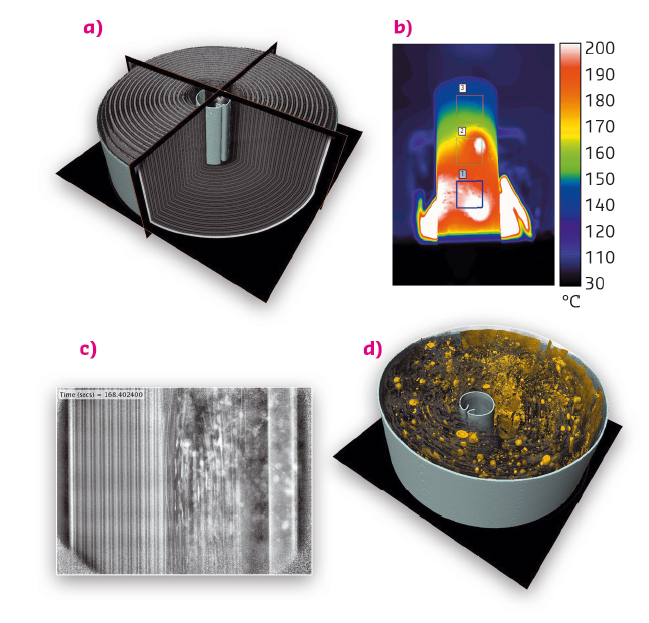- Home
- Users & Science
- Scientific Documentation
- ESRF Highlights
- ESRF Highlights 2015
- Structure of materials
- Capturing rapid failure mechanisms of lithium-ion batteries by high speed tomography
Capturing rapid failure mechanisms of lithium-ion batteries by high speed tomography
Improving the safety of lithium-ion batteries is imperative for their success in a range of applications from consumer electronics to automotive power trains. Here high speed tomography was used to image the rapid structural changes occurring within batteries during failure giving rise to an improved understanding of failure mechanisms and highlighting the importance of safety devices.
Li-ion batteries have become the technology of choice for consumer electronics, and in the future will find a diverse range of uses from mW to MW applications. The advancement of electric and hybrid electric vehicles requires high energy density batteries to operate under a wide range of demanding conditions where the safety of Li-ion batteries is of utmost importance. Recent high profile battery failures have highlighted the need for improved safety devices in commercial cell designs [1,2]. When a critical temperature is reached, the active electrode materials within a Li-ion battery begin to break down exothermically, generating large quantities of heat and causing a runaway reaction, known as thermal runaway. Safety devices such as pressure relief vents and positive temperature coefficient (PTC) devices are incorporated into commercial cells to help mitigate the risks associated with thermal runaway but little is understood about the dynamic mechanisms associated with thermally induced failures.
X-ray tomography has become a widely used technique for 3D structural analyses of electrochemical materials [3]. The exceptional photon flux density and brilliance at ID15A allowed acquisition of tomograms over very short periods of time providing unprecedented temporal resolution for 4D (time lapse) tomography whereby fast morphological changes were tracked in 3D over time. For the first time we have been able to image the nucleation and propagation of failure within working cells in real time. Simultaneous thermal imaging provided detailed information on the temperature of the cell during failure which was enabled by in situ containment apparatus (Figure 30) to protect beamline equipment from energy intensive failures.
 |
|
Fig. 30: Illustrative representation of the containment system; (b) photograph of the mounted containment system with labelled apparatus. |
Two commercial Li-ion batteries (18650 NMC cells) with different mechanical designs were imaged using high speed radiography and tomography during failure, to evaluate and compare the effectiveness of different cell safety devices. For example, it was found that an internal cylindrical support (Figure 31a) played an important role in improving the safety of a cell by providing structural support for the tightly wound electrode layer, and acting as a channel for gases to flow uninterrupted from the base of the cell to the vent during failure. Without the cylindrical support the internal architecture collapsed after venting, the consequences of which include increased risk of thermal runaway due to exposure of cell material to air.
 |
|
Fig. 31: (a) 3D reconstruction of a fresh cell with internal cylindrical support, (b) thermal image of a failing cell, (c) radiograph showing the propagation of thermal runaway and (d) post-mortem 3D reconstruction. |
One of the major safety concerns for battery manufacturers is the occurrence of pressure relief vent clogging during failure which occurs due to the re-distribution of failed material within the cell housing. High speed radiography at 1250 fps captured the rapid propagation of thermal runaway (Figure 31c) in both cells and highlighted the cause of clogging by identifying the shift of the bulk material towards the vent; clogging led to an uncontrolled ejection of the cell contents.
As well as thermal imaging which determined skin temperature for the cell, critical internal temperatures were estimated by pinpointing regions where aluminium and copper current collectors began to melt. During the rapid thermal runaway process, extreme temperature gradients of > 700°C were observed across the cells. Figure 31d shows a post-mortem reconstruction where the majority of the copper current collector within the cell has melted.
As well as enhancing our understanding of the role of safety devices and intelligent engineering designs in mitigating battery failure, this work has also demonstrated the use of high speed radiography, tomography and thermal imaging in concert, as a powerful diagnostic tool for understanding rapid failure mechanisms.
Principal publication and authors
In-operando high-speed tomography of lithium-ion batteries during thermal runaway, D.P. Finegan (a), M. Scheel (b,c), J.B. Robinson (a), B. Tjaden (a), I. Hunt (d), T.J. Mason (a), J. Millichamp (a), M. Di Michiel (b), G.J. Offer (d), G. Hinds (e), D.J.L. Brett (a) and P.R. Shearing (a), Nature Communications 6, 6924 (2015); doi: 10.1038/ncomms7924.
(a) Electrochemical Innovation Lab, Chemical Engineering Dept., UCL, London (UK)
(b) ESRF
(c) Synchrotron Soleil, Saint-Aubin (France)
(d) Mechanical Engineering Dept., Imperial College London (UK)
(e) National Physical Laboratory, Teddington (UK)
References
[1] AAIB, Air accident report: 2/2015 (2015).
[2] K. Bullis, Are Electric Vehicles a Fire Hazard?, MIT Tech Review (2013).
[3] M. Ebner et al., Science 342, 716-720 (2013).



